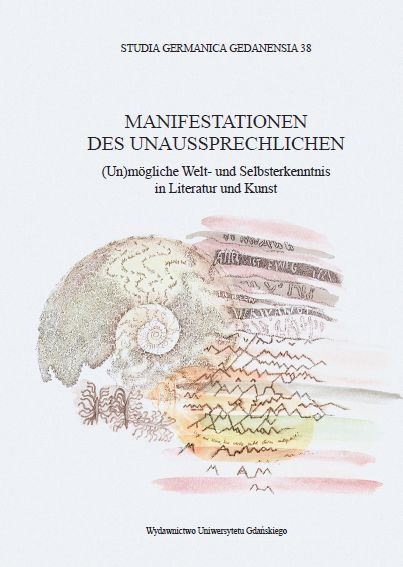Selbstverdammnis und verzögerte Liebeserklärung. Einige Bemerkungen zum Verhältnis von Schweigen und Reden in E.T.A. Hoffmanns Erzählung "Die Bergwerke zu Falun"
DOI:
https://doi.org/10.26881/sgg.2018.38.04Słowa kluczowe:
Ausgesprochenes, Unausgesprochenes, Selbstverdammnis, Bergwerk, TodAbstrakt
Der Artikel widmet sich der rhetorischen Spannung zwischen dem Ausgesprochenen und dem Unausgesprochenen in der Erzählung „Die Bergwerke zu Falun“ von E.T.A. Hoffmann. Die eigentliche Handlung nimmt ihren Lauf mit der Selbstverdammnis, die der Protagonist, Elis Fröbom, nach dem Tod seiner Mutter ausspricht. Dieser verbale Akt wird durch einen das Leben bejahenden „Gegenzauber“, d.i. die Liebeserklärung gegenüber Ulla, erst an dem Tag ausgeglichen, an dem Elis im Bergwerk stirbt. Die Spannung zwischen Schweigen und Reden stellt auch ein wesentliches Element in der unterirdischen Vision des Protagonisten dar, der eine Schlüsselbedeutung für die Interpretation des Werkes zukommt.
Downloads
Bibliografia
Deterding, Klaus, Das allerwunderbarste Märchen. E.T.A. Hoffmanns Dichtung und Weltbild, Bd. 3, Würzburg 2003.
Feldges, Brigitte, Ulrich, Stadler, E.T.A. Hoffmann. Epoche – Werk – Wirkung, München 1986.
Gold, Helmut, Erkenntnisse unter Tage. Bergbaumotive in der Literatur der Romantik, Opladen 1990.
Hartmann, Anneli, Der Blick in den Abgrund – E.T.A. Hoffmanns Erzählung „Die Bergwerke zu Falun“, in: Bettina Gruber, Gerhard Plumpe (Hrsg.), Romantik und Ästhetizismus. Festschrift für Paul Gerhard Klussmann, Würzburg 1993, S. 53–73.
Hildebrandt, Alexandra, „Genug sei es auch eigentlich, die Zeichen zu verstehen…“. Weisheit, Körper und Neurose in E.T.A. Hoffmanns Erzählung „Die Bergwerke zu Falun“, in: „Athenäum. Jahrbuch der Friedrich Schlegel‑Gesellschaft“ 5 (1995), S. 117–129.
Hoffmann, E.T.A., Die Serapions‑Brüder. Gesammelte Erzählungen und Märchen, Berlin 1827.
Köchy, Kristian, Ganzheit und Wissenschaft. Das historische Fallbeispiel der romantischen Naturforschung, Würzburg 1997 (= Epistemata. Reihe Philosophie, 180).
Pikulik, Lothar, E.T.A. Hoffmann als Erzähler. Ein Kommentar zu den „Serapions‑Brüdern“, Göttingen 1987.
Pohl, Klaus-D., „Sinnbild neuen Lebens“. Kristall und Kristallisation in der Kunst des 19. und 20. Jahrhunderts, in: Faszination Edelstein. Aus den Schatzkammern der Welt. Mythos Kunst Wissenschaft, Bern 1992, S. 76–86.
Rudke, Tanja, Der kirschrote Almandin. Phantastische Mineralogie bei E.T.A. Hoffmann, in: „E.T.A. Hoffmann Jahrbuch“ (16) 2008, S. 109–120.
Schnyder, Peter, Die Wiederkehr des Anderen. Ein Gang durch die Zeichenbergwerke zu Falun, in: Daniel Müller Nielaba, Yves Schuhmacher, Christoph Steier (Hrsg.), Figur – Figura – Figuration: E.T.A. Hoffmann, Würzburg 2011.
Seebacher, Katrin, Poetische Selbst-Verdammnis, Romantikkritik der Romantik, Freiburg i. B. 2000.
Selbmann, Rolf, Unverhofft kommt oft. Eine Leiche und die Folgen für die Literaturgeschichte, in: „Euphorion“ (94) 2000, S. 173–204.
Valk, Thorsten, Die Bergwerke zu Falun. Tiefenpsychologie aus dem Geist romantischer Seelenkunde, in: Günter Saße (Hrsg.), E.T.A. Hoffmann. Romane und Erzählungen, Stuttgart 2012.
Pobrania
Opublikowane
Jak cytować
Numer
Dział
Licencja
Copyright by Instytut Filologii Germańskiej, Wydawnictwo Uniwersytetu Gdańskiego.

 Uniwersyteckie Czasopisma Naukowe
Uniwersyteckie Czasopisma Naukowe




